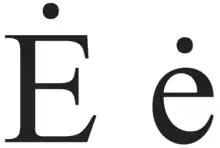Ė
Ė ė is a letter of the Latin script, the letter E with a dot above.

Doulos SIL glyphs for Majuscule and minuscule ė.
Use
It is the 9th letter in the Lithuanian alphabet, and is also used in the Colognian language of Cologne, Germany, Potawatomi language and Cheyenne language.
It was coined by Daniel Klein, the author of the first grammar of the Lithuanian language.[1]
Its pronunciation in Lithuanian is [eː], contrasting with ę, which is pronounced a lower [ɛː] (formerly nasalized [ɛ̃ː]) and e, pronounced [ɛ, ɛː].
This character is also used in Croatian to denote the old yat alongside the more usual ě.
Transliteration
This character is also used in strict Library of Congress transliteration when transliterating the Cyrillic letter Э э into the Latin alphabet.
Computing codes
| Preview | Ė | ė | ||
|---|---|---|---|---|
| Unicode name | LATIN CAPITAL LETTER E WITH DOT ABOVE | LATIN SMALL LETTER E WITH DOT ABOVE | ||
| Encodings | decimal | hex | decimal | hex |
| Unicode | 278 | U+0116 | 279 | U+0117 |
| UTF-8 | 196 150 | C4 96 | 196 151 | C4 97 |
| Numeric character reference | Ė | Ė | ė | ė |
| Named character reference | Ė | ė | ||
| ISO 8859-13, Windows-1257 | 203 | CB | 235 | EB |
See also
This article is issued from Wikipedia. The text is licensed under Creative Commons - Attribution - Sharealike. Additional terms may apply for the media files.